↓ Download the Full Newsletter (PDF)
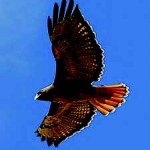
Hall’s Pond Welcomes Winter:
Hues and Rustles Winter’s nearly upon us, so it’s time to roll up the boardwalk until spring. Or is it? Winter’s bark is worse than its bite, and far softer than the baleful baying of the weather reporters of the everbleak outlook. So, get out and enjoy the winter, whatever the weather. Lord knows our feathered friends always make the best of it with good cheer. Birds and small mammals forage avidly in the snow, and Hall’s Pond usually enjoys lively wildlife from November through March.
Waterfowl find dabbling for greenery productive until the water actually freezes. You can depend on a few summer residents like Mallards and Canada Geese to spend at least as much time on
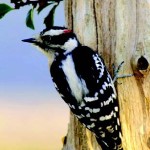
the pond as they do commuting to larger roosts along the Emerald Necklace and the Charles River. The same goes for the “grand old man” (the Great Blue Heron), that smaller sidekick (Black-crowned Night Heron), both of which may be found cooling their heels in low branches, and the occasional Double-crested Cormorant.
Overhead year-round you may catch glimpses of gulls (usually Herring and Ring-billed) and the local Redtailed Hawks (occasionally hounded by American Crows), but duck traffic increases come November.
In the still-warm hours of afternoon sun, Eastern Painted Turtles who live in the pond may clamber on exposed logs and grassy banks along the pond.
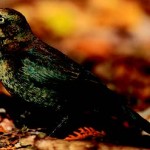
Grackles may hang around in small numbers at pond’s edge; keep an eye peeled for the unusual Rusty Blackbird; like the Red-winged Blackbird, it’s about ¾ the size of a Grackle but is actually iridescent rusty in winter (double-check your Peterson or Sibley field guides). Sparrows (winter types: juncos, white-throats, tree, a few of the year-round songs), and by Beacon Street, a bunch of the non-sparrow “House Sparrows.”
Though woodpeckers are common year-round, in winter they’re more visible and audible as they thrum dead branches or flit from trunk to trunk. In descending order of likelihood: Downy, Flicker, Hairy, Red-bellied; even Yellow-bellied Sapsuckers might winter over in soft weather. Most sport spots of red. Also spy red on robins, cardinals and Cedar Waxwings—and the berries that help them survive the winter.
Late-blooming asters (pink, blue, white) are eye-candy for winter strollers (no joggers, please!) as are rosy sedum, and white and pink phlox. In the formal garden, mark the chromatic evolution in the grand Japanese maple: violet-brown (with bright pink “noises”) to scarlet to orange to deep brown. Early bud-set in rhododendrons and other flowering bushes add incongruous notes of bright green and spring promise amid the decay. Even from across the ball-field, of course, yellowing willows add a power of brightness to even dull, rainy days.
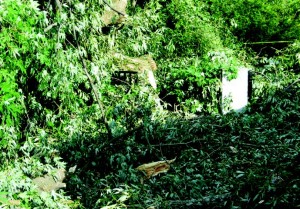 The Loss of an Old Friend
The Loss of an Old Friend
By Thomas D. Brady, Conservation Administrator/ Tree Warden, Town of Brookline
In the early afternoon of August 26, 2008 the magnificent willow which has graced the entrance to Hall’s Pond for many years split in half and came crashing to the ground during a moderate wind event. As you can see in the photo below the tree came down and destroyed several silver maples which were growing underneath it, and came crashing down on the gated entrance to the sanctuary.
At the moment the tree failed a group of sanctuary visitors was coming through the gate. The Willow and Silver Maple trees came crashing down all around these visitors. The willow tree actually landed on the granite pier which holds the ornamental gate and prevented the massive tree from falling all the way to the ground. It is a true blessing all the visitors emerged unscathed from this experience.

entrance gate. The Willow is now just a fond memory.
When this Willow tree failed it damaged several adjacent trees, a large portion of the chain link fence, the ornamental entrance gates, and the bike rack. At the time of this article the chain link fence has been repaired, the gates are under repair, and the bike rack needs to be replaced. And, the now barren landscape will be restored.
The Learning Project On three perfectly sunny days in October, three classes of sixth-graders from the Pierce School visited Hall’s Pond to learn about water and what happens to it as it cycles through the sanctuary. They examined the stormwater forebay, squeezed jewel weed and autumn leaves to consider how much water they contained (while also enjoying the way jewel weed seeds spring out of their pods when touched), and observed how a heron and many mallards were using the pond’s water resources.
The students, led by conservation commissioner Gail Fenton, tested samples of pond water. They found that the pH and oxygen levels within the pond were within a healthy range for plants and animals. Some of the young people thought that the pond water looked “gross” but learned that the water turbidity was within an acceptable range. Their results were to be reported to a database maintained by World Water Monitoring Day, an educational initiative sponsored in part by the U.S. Geological Survey and the Environmental Protection Agency. As one student said, “Wow, we are doing real science.”
These outdoor science classes at Hall’s Pond were provided, free of charge, by the Brookline Environmental Learning Project. Schools and other groups can arrange for outdoor programs, taught by local teachers, naturalists and environmentalists, at any of Brookline’s sanctuaries. The Brookline Environmental Learning Project, now administered by the Brookline Greenspace Alliance, was originated by the Friends of Hall’s Pond.

Birthright Israel Volunteers
Local alumni of Birthright Israel got an in-depth look at Hall’s Pond Sanctuary this summer, through a tour organized by Combined Jewish Philanthropies. Birthright Israel is an organization that funds educational trips to Israel for young adults. While some of the group knew that the sanctuary existed, either because they had walked past it or played soccer in adjacent Amory Field, this was their first actual visit. Ellen Forrester and Janice Provencher, copresidents of the Friends of Hall’s Pond, told them about the history and restoration of Hall’s Pond.
The visitors gained an understanding of the purpose and the ecological differences required in maintaining a public park versus a nature sanctuary. They volunteered to get their hands dirty and were put to work removing garlic mustard, an invasive plant, near the north pond overlook. The trash bags full of invasive plants were testimony to their eagerness to contribute in the caretaking of the sanctuary.
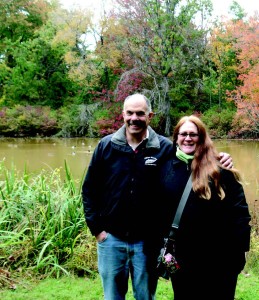
Visitor’s Views about Hall’s Pond
Oh my, someone has dumped oil into Hall’s Pond! When our family made the huge move from Back Bay to the suburb of Brookline, a distance of about one mile, we knew that our yard would be a lot bigger than the 25 square foot garden at our last home. We also were informed by our realtor that there was a park about 300 feet from our front door.
Imagine our huge surprise to find Amory Park and the incredible Hall’s Pond. One of our favorite spots on Cape Cod is the boardwalk through the cedar swamp at Marconi Station. This boardwalk, and that at Hall’s Pond, allow the viewer a unique view of the surroundings without disturbing the ecological structure of the grounds. At Hall’s Pond the overlooks on the boardwalk allow us an intimate look at the turtles, birds and other wildlife that share the Sanctuary.
The Friends of Hall’s Pond do a terrific job at maintaining this wonderful jewel. We also found out that the “oil” is actually a natural by-product of decaying plant/tree materials.
–Jerry Katz, Sidney Boucher-Katz, Laurie & Rochelle Katz (children not pictured)
The Friends of Hall’s Pond welcomes the Katz family as new neighbors to the Sanctuary. They have spent a great deal of time getting to know their new surroundings and enjoy having such a treasure just steps from their front door.
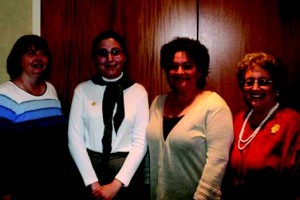
Annual Meeting
New and old Friends gathered together at the Annual Meeting of the Friends of Hall’s Pond on June 16, 2008. The Friends awarded the MIT Epsilon Theta Fraternity an Outstanding Service Award. Alyssa Kersting, Community Service Chair, accepted the award on behalf of the fraternity. For more than 25 years Epsilon Theta members, while residents in their St. Paul Street fraternity home, have participated in the Friends’ annual spring and fall community work days at Hall’s Pond and Amory Woods. They have carried out their fraternity pledge to develop lasting friendships, to help others achieve their respective goals, and to be responsible to others and the community. Their commitment to these values has resulted in immeasurable contributions to the sanctuary.
The meeting also featured a slide show presentation and panel discussion on sanctuary management. The audience’s thoughtful questions were addressed by panelists Randolph Meiklejohn and Gail Fenton. Both are board members of the Friends of Hall’s Pond and serve on the Brookline Conservation Commission.
Summary reports on the various aspects of the Friends’ organization were given and board nominations and re-elections were held. The Board welcomes your suggestions for award recipients, topics for future annual meetings, and content ideas for future newsletters.
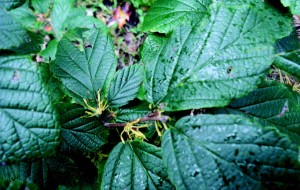
In and Around the Garden Look what is in bloom!
Who would have thought that in the waning days of Autumn with cold weather just setting in something would just be beginning to bloom. Planted at the spring 2008 work day, this Hamamelis virginiana (aka Common Witchhazel) is doing quite well in the upland area of the sanctuary.
With leaves still hanging on, soon to be a blazing yellow, the bright yellow blossoms of this magnificent native shrub are difficult to find. See if you can spot this shrub on your next visit to the sanctuary.
